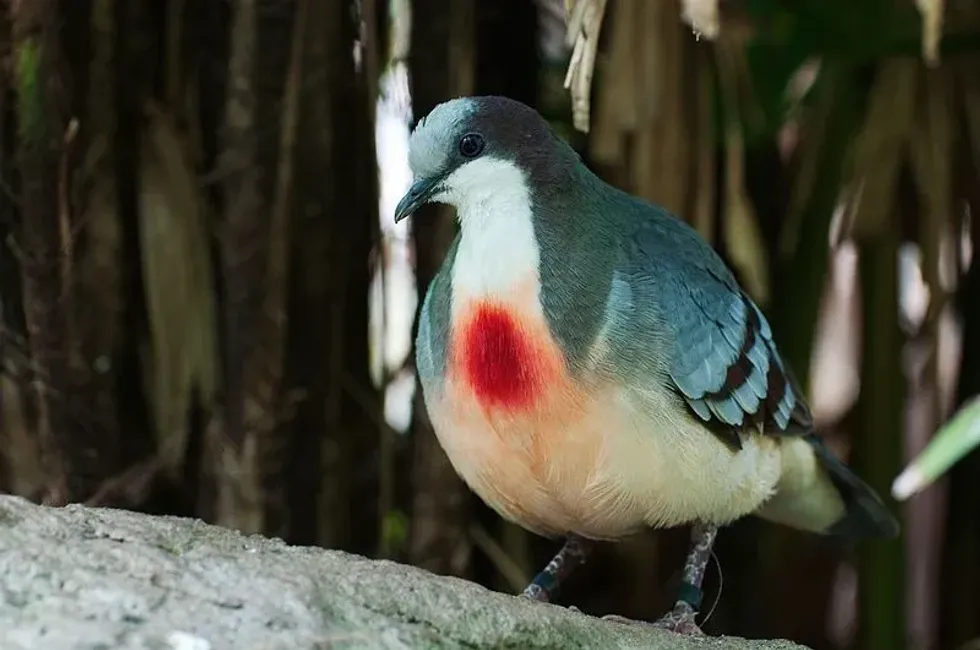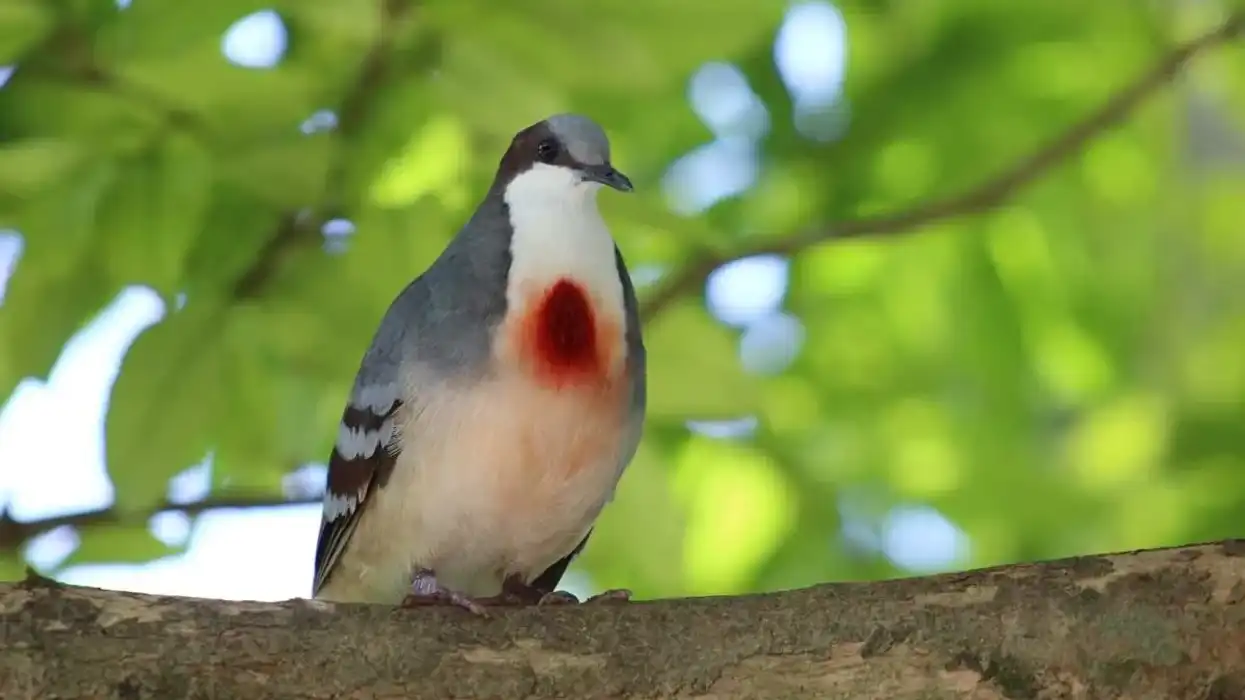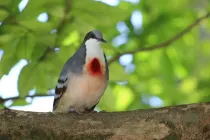Fun Luzon Bleeding Heart Facts For Kids

The Luzon bleeding-heart dove (Gallicolumba luzonica) is one of the members of the ground dove species that is of the family Columbidae. These are one of the five bleeding-heart species in the Philippine islands.
These birds are endemic to the Island of Luzon. They got their name due to the distinct feature that looks like a red patch or bleeding wound flowing out of their breast, extending to their belly.
This patch is brighter in males than females. These are medium-sized birds of a slate grey color. As these species are iridescent, they exhibit blue, purple, or green colors.
This family and genus consist of pigeons and doves. The population of these species is declining, and the conservation status is Near Threatened (IUCN).
Predators of Luzon bleeding-heart are birds of prey, mammals, reptiles, and humans (pet trade). They use thick undergrowth surroundings to escape predators. The English zoologist introduced the family Columbidae in 1820.
Several species of plants depend on these birds for seed dispersal. The most diverse non-passerine clades of neoavians are the order Columbiformes. Although they have a longer life span in captivity or zoo, they are hosts to parasites, which cause cankers – resulting in illness and even death.
You may also enjoy California condor facts and frigatebird facts.
Luzon Bleeding-Heart Interesting Facts
What type of animal is a Luzon bleeding heart?
Gallicolumba luzonica is a dove or pigeon of the order Columbiformes and genus Gallicolumba. These bird species are secretive, quiet, and shy. They are found on forest floors.
They fly for a short distance and then escape on foot when approached. They are peaceful in the wild but become aggressive in captivity or zoo.
The males have to be kept separately, and only one pair must be kept together. They do move from place to place but most of the time remain in the same area. The three subspecies of the bleeding heart pigeon are Gallicolumba luzonica grisealateralis, Gallicolumba luzonica rubiventris, and Gallicolumba luzonica luzonica.
What class of animal does a Luzon bleeding heart belong to?
These species of bleeding hearts belong to the class Aves of animals.
How many Luzon bleeding-heart are there in the world?
The data on the population of bleeding hearts is not available.
Where does a Luzon bleeding heart live?
The bleeding heart pigeon occupies a wide range of habitats in Luzon as these birds are endemic to this island. Their habitat consists of Luzon and Polillo in the Philippines. The subspecies Gallicolumba luzonica grisealateralis are found in the northern part of the Luzon Islands.
Gallicolumba luzonica rubiventris are only found in the Catanduanes islands. Gallicolumba luzonica luzonica is found in the central and southern parts of the Luzon and Polillo Islands. These islands are in the northern part of the Philippine archipelago.
What is a Luzon bleeding-heart's habitat?
The habitat range of the Luzon bleeding-heart dove (Gallicolumba luzonica) includes tropical and terrestrial forest regions. This range consists of low to medium-height trees, vines, and shrubberies for their nest during breeding seasons.
They feed mainly on the forest floor. To escape predators, they use thick undergrowths. They can be found at an altitude range of 4593 ft (1,400 m).
Who do Luzon bleeding-hearts live with?
The Luzon bleeding-heart dove (Gallicolumba luzonica) lives on its own or in pairs during the breeding season.
How long does a Luzon bleeding-heart live?
Luzon bleeding-heart dove (Gallicolumba luzonica) has a lifespan of 15-20 years. They live for about 15 years in the wild whereas in captivity it is closer to 20 years.
How do they reproduce?
The Luzon bleeding-heart dove (Gallicolumba luzonica) is monogamous in captivity or zoo, usually pairing for life. These ground birds use trees only for nesting. The breeding season's nesting occurs in mid-May when other subspecies also nest in the Philipines.
The males try to attract females with courtship displays during breeding. The male inflates his breast showing his bleeding wound mark while chasing the female.
Males coos and bows his head once the female is smitten. It is quite a task to observe these species in their habitat, and hence there is only a record of breeding in captivity or zoo. The female lays two white and creamy eggs.
Both the parents take turns incubating eggs for 17 days. The female incubates at night, and the male incubates the eggs in the day.
They switch places twice a day for 17 days. Parents feed the fledglings for up to one month even though the young leave the nest after 10-14 days. The young birds need to be separated from their parents once they start developing adult plumage around two or three months.
If they are not separated, the parents will attack the young birds. The young birds reach sexual maturity around 18 months.
The young birds are fed crop milk. The crop milk has the same consistency as any mammal milk. The digestive tract of both the parents produces high-protein and high-fat crop milk.
What is their conservation status?
The conservation status of the Luzon bleeding-heart dove (Gallicolumba luzonica) is Near Threatened as per the IUCN. The population started declining due to reduced natural habitat.
They are also listed as Near Threatened in the Philippines Red Data Book. The native people capture these birds for the pet trade and their meat. The population of these endemic species is affected by the increasing population of cities with increasing deforestation.
Luzon Bleeding-Heart Fun Facts
What do Luzon bleeding hearts look like?

Luzon bleeding-heart dove is a ground bird that has a slate-grey top. The iridescence gives their feathers green, blue, or purple color. They have a characteristic blood-like red patch on their breast.
The males have a brighter blood-like red patch than the females. This blood patch looks like blood running down from their breast to the white underbelly. These species have light bluish-grey head and wings with black bills.
They are long-legged and short-tailed. They have three dark red-brown bands on their wings. Light pink feathers surround the red patch on their breast. They have red legs and feet.
There is no difference between the male and female bird species. However, the males do appear to have larger and wider heads than the females. These birds are bilaterally symmetrical.
How cute are they?
Luzon bleeding-heart dove species look like pigeons with a red patch. So, this animal is considered cute.
How do they communicate?
Luzon bleeding-heart dove species communicate through vocalization, body language, and touch. They produce a single long 'cooooo' with a raised pitch in the middle of the call. They are mostly silent. The males use soft 'co-co-coo' during courtship. During this time, the male chases the female with an inflated breast.
How big is a Luzon bleeding heart?
The Luzon bleeding-heart pigeon species is 11.8 in (30 cm) long. They can be twice the size of a chipping sparrow.
How fast can a Luzon bleeding heart fly?
The exact flight speed of this species is unknown. These species spend time on the forest floors, and when they do fly, they fly only for a short distance.
How much does a Luzon bleeding heart weigh?
This bird species are around 0.4 lb (181.4 g) in weight. They are two times smaller than the pigeon guillemot and four times larger than the western kingbird.
What are the male and female names of the species?
The female is called a hen and a male is called cock.
What would you call a baby Luzon bleeding heart?
The baby Luzon bleeding-heart bird is called a chick or squab.
What do they eat?
These birds feed on the forest floors. These birds are omnivorous, feeding on berries, seeds, and various worms and insects on the floor of the forests they inhabit. In captivity or zoo, they can be fed vegetables, cheese, and oilseeds, like safflower, and hookbill seeds. They are also fed boiled rice and softbill pellets.
Are they dangerous?
No, this animal is not dangerous to human beings.
Would they make a good pet?
Yes, these animals do make good pets. These species are captured for the pet trade, one of the reasons why they have a threatened conservation status.
Did you know...
The native people in the Philippines call these animals Puñalada.
There are five species of bleeding heart birds. The other four are Mindoro bleeding-heart (Gallicolumba platenae), Mindanao bleeding heart (Gallicolumba criniger), negros bleeding-heart (Gallicolumba keayi), and Sulu bleeding heart (Gallicolumba menagei).
The first time that the Luzon bleeding heart was bred in captivity was by Rosie Alderson in 1893 in England. In 1917, they were first bred in the United States.
It is very difficult to breed these pigeons. They need to be comfortable and need proper housing.
In the United States, only Luzon bleeding-heart pigeons and Bartlett's bleeding heart pigeons exist in moderate numbers.
At Hamilton Zoo, New Zealand, there is a pair of Luzon bleeding-heart pigeons.
Like all other pigeons, these birds also drink water by sucking continuously without lifting their head.
Their scientific name 'Gallicolumba' has two elements, Galli meaning 'chicken' and Columba meaning 'dove.' This name is given because they look like chicken when foraging for food.
All species of bleeding-heart consume more animal food than any other pigeon.
The Mindoro bleeding-heart pigeon species are also known as kulo-kulo and manuk-manuk.
The Sulu bleeding-heart pigeon species is critically endangered.
Bartlett's bleeding-heart pigeon species is also known as Mindanao bleeding heart pigeon, hair-breasted bleeding-heart pigeon, and Barlett's bleeding-heart pigeon.
Why are Luzon bleeding-hearts called so?
These animals are endemic species of Luzon, so Luzon is present in their name. These animals are called bleeding-heart due to the distinct feature that looks like a red patch or bleeding wound flowing out of their breast, extending to their belly. This patch is brighter in males than females.
Do Luzon bleeding-hearts migrate?
These animals are found on the floor of forests than flying in the sky. So, they are no migratory birds. The birds with the longest distance of migration are Arctic terns.
Here at Kidadl, we have carefully created lots of interesting family-friendly animal facts for everyone to discover! Learn more about some other birds from our common loon facts and scarlet macaw facts pages.
You can even occupy yourself at home by coloring in one of our free printable Luzon bleeding heart coloring pages.
We Want Your Photos!
More for You
See All
Bachelor of Engineering specializing in Aeronautical/Aerospace Technology, Master of Business Administration specializing in Management

Arpitha RajendraBachelor of Engineering specializing in Aeronautical/Aerospace Technology, Master of Business Administration specializing in Management
With a background in Aeronautical Engineering and practical experience in various technical areas, Arpitha is a valuable member of the Kidadl content writing team. She did her Bachelor's degree in Engineering, specializing in Aeronautical Engineering, at Nitte Meenakshi Institute of Technology in 2020. Arpitha has honed her skills through her work with leading companies in Bangalore, where she contributed to several noteworthy projects, including the development of high-performance aircraft using morphing technology and the analysis of crack propagation using Abaqus XFEM.
Bachelor of Arts specializing in English Literature, Masters of Art specializing in English and Communication Skills

Sonali RawatBachelor of Arts specializing in English Literature, Masters of Art specializing in English and Communication Skills
Sonali has a Bachelor's degree in English literature from Guru Gobind Singh Indraprastha University and is currently pursuing a Master's in English and Communication from Christ University. With considerable experience in writing about lifestyle topics, including travel and health, she has a passion for Japanese culture, especially fashion, and anime, and has written on the subject before. Sonali has event managed a creative-writing festival and coordinated a student magazine at her university. Her favorite authors are Toni Morrison and Anita Desai.
Disclaimer
1) Kidadl is independent and to make our service free to you the reader we are supported by advertising. We hope you love our recommendations for products and services! What we suggest is selected independently by the Kidadl team. If you purchase using the Buy Now button we may earn a small commission. This does not influence our choices. Prices are correct and items are available at the time the article was published but we cannot guarantee that on the time of reading. Please note that Kidadl is a participant in the Amazon Services LLC Associates Program, an affiliate advertising program designed to provide a means for sites to earn advertising fees by advertising and linking to Amazon. We also link to other websites, but are not responsible for their content.
2) At Kidadl, we strive to recommend the very best activities and events. We will always aim to give you accurate information at the date of publication - however, information does change, so it’s important you do your own research, double-check and make the decision that is right for your family. We recognise that not all activities and ideas are appropriate for all children and families or in all circumstances. Our recommended activities are based on age but these are a guide. We recommend that these ideas are used as inspiration, that ideas are undertaken with appropriate adult supervision, and that each adult uses their own discretion and knowledge of their children to consider the safety and suitability. Kidadl cannot accept liability for the execution of these ideas, and parental supervision is advised at all times, as safety is paramount. Anyone using the information provided by Kidadl does so at their own risk and we can not accept liability if things go wrong.
3) Because we are an educational resource, we have quotes and facts about a range of historical and modern figures. We do not endorse the actions of or rhetoric of all the people included in these collections, but we think they are important for growing minds to learn about under the guidance of parents or guardians.







